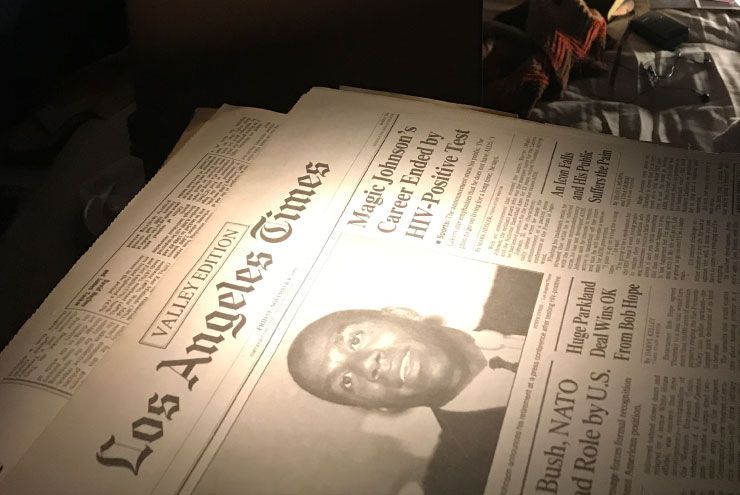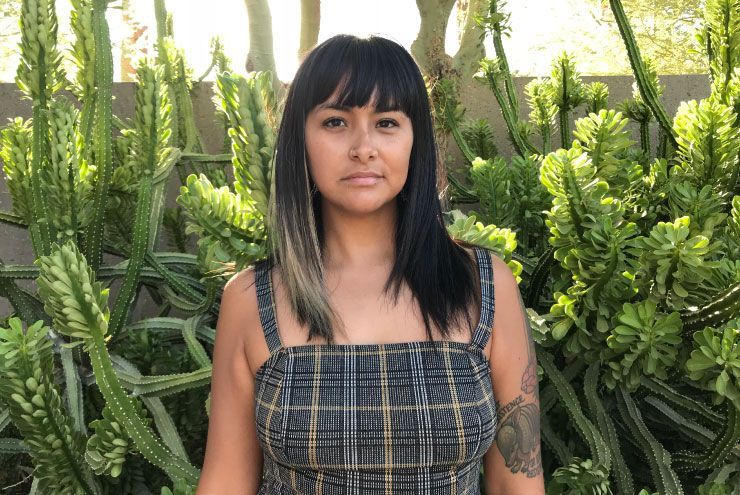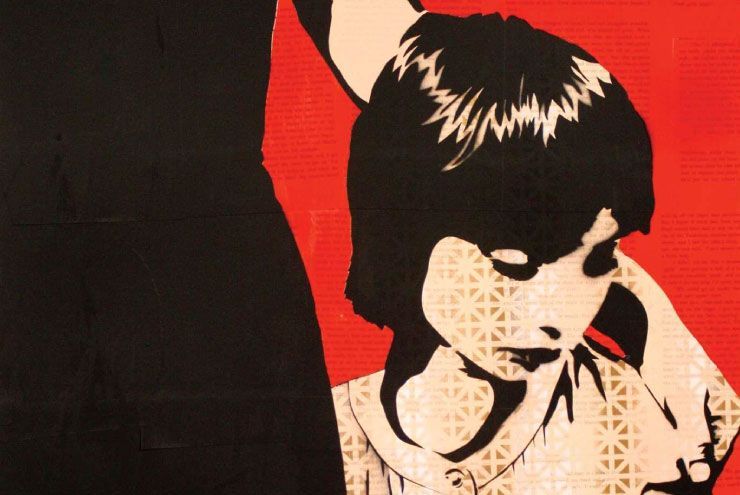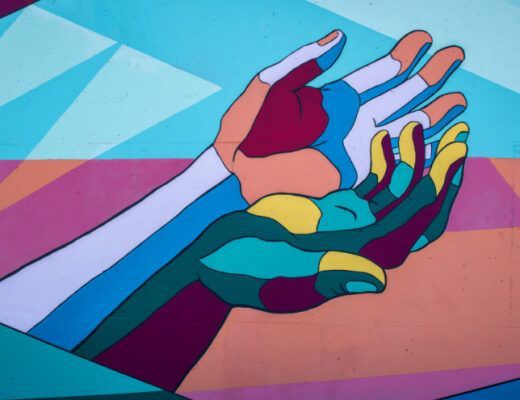By Barrett White
The opening salvo of Queerskins: A Love Story plays out over the backdrop of AIDS Crisis America. Ed (Drew Moore) and Mary-Helen (Hadley Boyd) are driving down a country road filled with memories of their son, Sebastian (Michael DeBartolo), who has recently passed away—a victim of the crisis. Using photorealistic virtual reality (VR), the viewer is thrust into the middle of this scene, witnessing the couple’s heart-wrenching conversation firsthand from the back seat of their Cadillac. On the seat next to you (in VR) is a box of belongings that was sent back with Sebastian’s body. With your VR hands, you fumble through his memories while his parents discuss the terms of his death within spitting distance of you.
“Not only does the drama unfolding in intimate proximity reveal the person Sebastian was, [but] by interacting with a collection of personal belongings, visitors reconstruct the story of his life,” Queerskins creative and technical director Cyril Tsiboulski says of the installation, which is poised to be the sleeper hit of this year’s Houston Cinema Arts Festival, taking place on November 8-12. “One person might have a very different response to picking up a statue of the Virgin Mary than another person would. It’s the act of handling and examining objects that really activates the experience. It invokes visitors’ own memories and history, and that is very powerful.”
Beyond the heartbreak, Queerskins is a film of familial responsibility and queer possibility. The idea for such a production was the brainchild of Illya Szilak, who is trained as an infectious disease physician/HIV specialist. Szilak based the story of Queerskins on her experiences treating patients with HIV/AIDS.
Though Queerskins can certainly be appreciated as a stand-alone installation, visitors are encouraged to explore the larger surrounding exhibit (which is tangible in real-life), opening drawers and rummaging through hidden memorabilia, much of which is recognizable from the virtual experience.
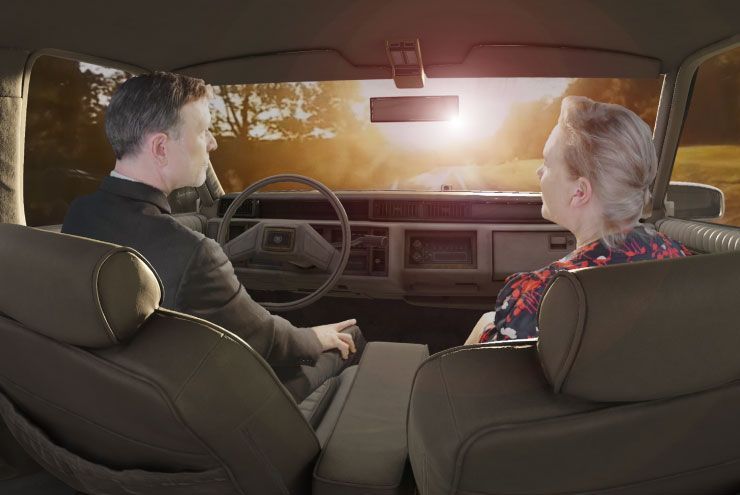
Ed (Drew Moore) and Mary-Helen (Hadley Boyd) drive down a country road filled with memories of their son, Sebastian (Michael DeBartolo), who has recently passed away from AIDS. Using photorealistic virtual reality (VR), the viewer is thrust into the middle of this scene, witnessing the couple’s heart-wrenching conversation firsthand from the back seat of their Cadillac.
Entering the Queerskins installation, I was asked to “read Sebastian’s diary, flip through newspapers from 1985, thumb through vintage recipe cards stamped with quotes from Mary-Helen, and play records”—truly a tactile film festival experience like no other. At the film’s premiere at the Tribeca Film Festival, visitors were asked to seek out an object that resonated with their own story of love and loss, and to be anonymously photographed with it. These photos were then posted on Queerskins’ official Instagram. Large scale photos of participants and their objects, captured at Tribeca by Tagger Yancey and Julienne Schaer, were later incorporated into the installation. “We did not anticipate how deeply and personally the act of choosing an object and being photographed would affect people,” Szilak says. “I’m still trying to understand how this combination of the virtual and the real generated such an open and intense exchange with strangers. Sebastian’s story is unique, but the story of love and loss is universal—everybody has one.”
Richard Herskowitz, artistic director of the Houston Cinema Arts Festival, highlights Queerskins’ position as a collaborative installation, something he is proud to acknowledge the festival eagerly promotes. “We’ve always been interested, as a ‘cinema arts festival,’ in the cutting edge of cinematic experimentation, and we’ve also been very interested—like filmmakers have been in recent years—in immersive cinema,” he says, musing on a previous year’s piece that was projected at the Houston Museum of Natural Science planetarium, and another by artist Vanessa Renwick, which was screened on a tent with the audience lying beneath it. “That kind of rethinking of how you experience cinema beyond the standard movie screen is something we’ve been exploring since the very beginning. I was looking for good, immersive work, and [Queerskins] was the best one I’ve seen all year.”

Though ‘Queerskins’ can certainly be appreciated as a stand-alone installation, visitors are encouraged to explore the larger surrounding exhibit (which is tangible in real-life), opening drawers and rummaging through hidden memorabilia, much of which is recognizable from the virtual experience.
For the past 10 years, Herskowitz has served as the artistic director for the festival, flying in annually from his home in Oregon to piece it all together. The Houston arts scene scouted Herskowitz for the festival, placing it among many other prized works on his impressive resume, which includes the Ashland Independent Film Festival (Ashland, Oregon), the Virginia Film Festival (Charlottesville, Virginia), and Cinema Pacific (Eugene, Oregon).
While the Houston scene has certainly benefited from Herskowitz at the helm of its cinema arts fest, he says that the city’s arts scene has equally impressed him. Building the festival over the last decade helped to solidify Houston as a burgeoning arts city, attracting attendees like Tilda Swinton and talents like native Houstonian Richard Linklater, whose work will make an appearance in the retrospective theme of this year’s well-polished tin anniversary (which also happens to be the 25th anniversary of what many consider Linklater’s magnum opus, Dazed and Confused). For Herskowitz, the 10th anniversary of the festival also seemed like a good year to make a triumphant exit—not with any bitter taste over the event, but to focus on his role as the executive director of the Ashland Independent Film Festival back home.
For a real blowout on year 10, Herskowitz put together a gem of a lineup. In addition to Queerskins, the Houston Cinema Arts Festival will screen large-release premieres of Widows (starring Viola Davis and Liam Neeson) and Maria By Callas, a dramatic biopic of the famed opera singer and gay icon Maria Callas.
The Rest I Make Up, a documentary on María Irene Fornés by director Michelle Memran, is also set to screen at the festival. The documentary tells the life story of Fornés, who the world recently lost at the end of October. A pioneering queer, immigrant playwright, Fornés was a creative avant-garde force in the theatre community, penning many award-winning plays, including a finalist for the Pulitzer. Edward Albee, Ellen Stewart, and others of Broadway fame offer their thoughts on Fornés’ work in the film, which shines a warm, rhapsodic light on her life as she struggled with Alzheimer’s toward the end.
Going out on a high note, indeed. Herskowitz told the Houston Chronicle, “It’s really one of the best gigs of my life.”
You can explore more of the Queerskins: A Love Story VR experience on Instagram at @queerskins. A free discussion with Illya Szilak and Kim Voynar will be held on Friday, November 9 at noon. The Queerskins installation will be open 12 p.m. to 9 p.m. every day of the festival, November 8-12.
What: Queerskins: A Love Story at the Houston Cinema Arts Festival
When: November 8-12, 2018
Where: Queerskins is on view at Rice Media Center (2030 University Blvd). Other Houston Cinema Arts Festival events will be held at various venues around Houston. For more information, click here.


